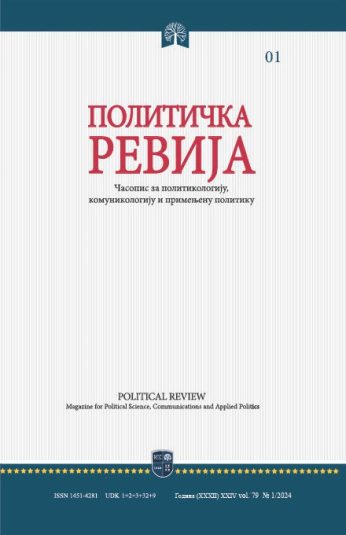Тема броја
ОГЛЕДИ И СТУДИЈЕ
КАРАКТЕРИСТИКЕ ПРЕТЊИ УРБАНОЈ БЕЗБЕДНОСТИ
Сажетак
Урбана безбедност представља комплексно истраживачко поље, које чине различити безбедносни проблеми (ризици, рањивости, претње), разнолики актери, тј. провајдери који учествују у остваривању и унапређењу безбедности урбаних средина, као и стратегије, активности и средства које су усмерене ка решавању безбедносних проблема, а у циљу заштите виталних вредности у урбаној средини. Безбедносна претња представља један од кључних, а можда и најважнији елемент урбане безбедности. Имајући то у виду, у раду ће бити представљене неке од најчешће проблематизованих безбедносних претњи у урбаној средини, као и опис њихових карактеристика, узрока и последица. Осим тога у раду ће такође бити издвојене неке од основних специфичности претњи урбане безбедности, а у циљу утврђивања заједничких карактеристика и евентуалних образаца у погледу узрока и испољавања претњи урбаној безбедности. На крају ће бити представљени и могући критеријуми за класификацију безбедносних претњи урбаних средина, а као израз потребе даљег утемељења и систематизације области урбане безбедности.
Референце
- Липовац, Милан, „Допринос конструктивистичке парадигме студијама безбедности”,Социолошки преглед, Српско социолошко друштво, Београд, 3/2013, 439-460.
- Abrahamsen, Rita, Hubert, Don, Williams, Michael C., „Guest editor’s introduction to special issue on urban insecurities“, Security Dialogue, Sage, Thousand Oaks, 4-5/2009, 363-372.
- Abrahamsen, Rita, Williams, Michael C., „Securing the city: private security companies and non-state authority in global governance“, International relations, Sage, London, 2/2007, 237-253.
- Bartone, Carl R., Bernstein, Janis, Leitmann, Josef, Managing the environmental challenge of Mega-Urban Regions, Asian Institute of Technology, Bangkok,
- Beall, Jo, Cities, Terrorism and Urban Wars of the 21st Century, DESTIN, London, 2007.
- Borell, Klas, „Terrorism and everyday life in Beirut 2005: Mental reconstructions, precautions and normalization“, Acta Sociologica,Sage, London, 1/2008, 55-70.
- Brennan, Ellen, Population, urbanization, environment, and security: a summary of the issues. Environmental Change and Security Project Report (Issue 5), The Woodrow Wilson Center, Washington, D.C., 1999.
- Bugliarello, George, „Urban security in perspective“, Technology in Society,Elsevier, New York, 4/2003, 499-507.
- Campbell, David, Graham, Stephen, Bertrand Monk, Daniel, „Introduction to urbicide: the killing of cities?“, Internet, http://muse.jhu.edu/journals/theory_and_event/toc/tae10.2.html, 25/4/2019
- Coward, Martin, “Network-centric violence, critical infrastructure and the urbanization of security”, Security Dialogue,Sage, Thousand Oaks, 4-5/2009, 399-418.
- Coward, Martin, “’Urbicide’ Reconsidered”, Internet http://muse.jhu.edu/journals/theory_and_event/toc/tae10.2.html, 25/4/2019
- Dimitrijević, Ivan, Paraušić, Ana, Katalog baza podataka za istraživanja u oblasti bezbednosti, Centar za primenjenu bezbednost, Beograd, 2017.
- Driver, Felix, Gilbert, David, Imperial cities. Manchester University Press, Manchester, 2003.
- Edward, Peter, „The ethical poverty line: A moral quantification of absolute poverty“, Third World Quarterly, Routledge, Abingdon, 2/2006, 377-393.
- Ejdus, Filip, Međunarodna bezbednost: teorije, sektori i nivoi, Službeni glasnik, Beograd,
- Gat, Azar, A History of Military Thought: From the Enlightenment to the Cold War, Oxford University Press, Oxford, 2001.
- Gaviria, Alejandro, Pagés, Carmen, „Patterns of crime victimization in Latin American cities“, Journal of Development Economics,Elsevier, Amsterdam, 1/2002, 181-203.
- Glaeser, Edward, Sacerdote, Bruce, Why is there more crime in cities?, National Bureau of Economic Research, Cambridge, 1996.
- Graham, Stephen, Marvin, Simon, Splintering Urbanism: Networked Infrastructures, Technological Mobilities and the Urban Condition, Routledge, London, 2001.
- Hoelscher, Kristian, Nussio, Enzo, „Understanding unlikely successes in urban violence reduction“, Urban Studies,Routledge, Abingdon, 11/2016, pp. 2397-2416.
- Jütersonke, Oliver, Muggah, Robert, Rodgers, Dennis, „Gangs, urban violence, and security interventions in Central America“, Security dialogue, Sage, Thousand Oaks, 4-5/2009, 373-397.
- Koschnik, Wolfgang, Standard Dictionary of the Social Science, French & European Pubns, Paris, 1992.
- Lipovac, Milan, „Konceptualna analiza bezbednosti“,u zborniku: Međunarodna bezbednost: Teorijski pristupi (ur. Milan Lipovac, Dragan Živojinović), Inovacioni centar Fakulteta bezbednosti, Beograd, 2014, 49-72.
- Mamford, Luis, Kultura gradova, Mediterran Publishing, Novi Sad, 2010.
- Manwaring, Max, Street Gangs: The New Urban Insurgency, Strategic Studies Institute, US Army War College, Carlisle, 2005
- Meško, Gorazd, Tominc, Bernarda, Sotlar, Andrej, „Urban security management in the capitals of the former Yugoslav republics“, European journal of criminology, Sage, London, 3/2013, 284-296.
- Moser, Caroline, McIlwaine, Cathy, „Latin American urban violence as a development concern: towards a framework for violence reduction“, World development,Pergamon, Oxford, 1/2006, 89-112
- Moser, Caroline, Rodgers, Dennis, Change, violence and insecurity in non-conflict situations, Overseas Development Institute, London, 2005.
- Muggah, Robert, Researching the urban dilemma: Urbanization, poverty and violence. International Development Research Centre, Ottawa, 2012.
- Paraušić, Ana, „Smart city ICT Solutions for Enhancing Human Security“, In: The Proceedings of Human Security and New Technologies. 4th International Academic Conference on Human Security (Ed. Svetlana Stanarević, Goran J. Mandić , Ljubinka Katić), Faculty of Security Studies, Human Security Research Center, Belgrade, 2018, 241-247.
- Preece, Julia, „Widening participation for social justice: poverty and access to education“, In: Widening access to education as social justice (ed. Oduaran, Akpovire, Bhola, Harbans, Springer, Dordrecht, 2006, 113-126.
- Rosenau, William, „“Every room is a new battle”: The lessons of modern urban warfare“, Studies in Conflict & Terrorism,Taylor & Francis, Philadelphia, 4/1997, 371-394.
- Shapiro, Michael, „Managing urban security: City walls and urban metis”, Security Dialogue, Sage, Thousand Oaks,4-5/2009, 443-461.
- Tilly, Charles, Cities and the Rise of States in Europe, AD1000 to 1800. Westview, Boulder, 1994
- vanDijk, Jan, „Criminal Victimisation: A Global View“, In: Surveying Crime: A Global Perspective – Proceedings of the International Conference, ISTAT, Rome, 1998, 63-93.
- Winton, Alisa, „Urban violence: a guide to the literature“, Environment and Urbanization, Sage, Thousand Oaks, 2/2004, 165-184.
- Wirth, Louis, „Urbanism as a Way of Life“, American journal of sociology, University of Chicago Press, Chicago, 1/1938, 1-24.
- Wolfers, Arnold, „National security as an ambiguous symbol“, Political science quarterly, Academy of Political Science, New York,4/1952, 481-502.

